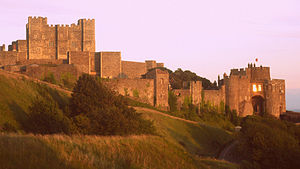Dover castle
| Dover Castle | |
|---|---|
| Dover, Kent, England | |

Entrance to Dover Castle viewed from the north-west
|
|
| Coordinates | 51°07′47″N 1°19′17″E / 51.1297°N 1.3214°E |
| Type | Norman castle |
| Site information | |
| Owner | English Heritage |
| Condition | Intact |
| Site history | |
| Built | 12th century |
| Built by | Henry II |
| Events | First Barons' War |
Dover Castle is a medieval castle in Dover, Kent. It was founded in the 11th century and has been described as the "Key to England" due to its defensive significance throughout history. It is the largest castle in England.
The site may have been fortified with earthworks in the Iron Age or earlier, before the Romans invaded in AD43. This is suggested on the basis of the unusual pattern of the earthworks which does not seem to be a perfect fit for the medieval castle. Excavations have provided evidence of Iron Age occupation within the locality of the castle, but it is not certain whether this is associated with the hillfort. There have also been excavations on the mound which the church and Roman Pharos are situated on, which has been discovered to be a Bronze Age mound.
The site also contained one of Dover's two 80-foot (24 m) Roman lighthouses (or Pharoses), one of which still survives, whilst the remains of the other are located on the opposing Western Heights, across the town of Dover. On the site is a classic montrol (campsite) where the Normans landed after their victorious conquest.
After the Battle of Hastings in October 1066, William the Conqueror and his forces marched to Westminster Abbey for his coronation. They took a roundabout route via Romney, Dover, Canterbury, Surrey and Berkshire. From the Cinque Ports foundation in 1050, Dover has always been a chief member—it may also have been this that first attracted William's attention, and got Kent the motto of Invicta. In the words of William of Poitiers:
Then he marched to Dover, which had been reported impregnable and held by a large force. The English, stricken with fear at his approach had confidence neither in their ramparts nor in the numbers of their troops ... While the inhabitants were preparing to surrender unconditionally, [the Normans], greedy for money, set the castle on fire and the great part of it was soon enveloped in flames...[William then paid for the repair and] having taken possession of the castle, the Duke spent eight days adding new fortifications to it'. The Castle was first built, entirely out of clay. It collapsed to the ground and the clay was then used as the flooring for many of the ground-floor rooms.
...
Wikipedia

